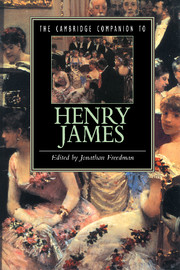Book contents
- Frontmatter
- Introduction: The Moment of Henry James
- 1 Men, Women, and the American Way
- 2 The James Family Theatricals
- 3 Henry James at Work
- 4 Henry James and the Invention of Novel Theory
- 5 Henry James and the Idea of Evil
- 6 Queer Henry In the Cage
- 7 The Unmentionable Subject in "The Pupil"
- 8 Realism, Culture, and the Place of the Literary: Henry James and The Bostonians
- 9 Lambert Strether's Excellent Adventure
- 10 James's Elusive Wings
- 11 Henry James's American Dream in The Golden Bowl
- 12 Affirming the Alien: The Pragmatist Pluralism of The American Scene
- Suggestions for Further Reading
- Index
- Series List
6 - Queer Henry In the Cage
Published online by Cambridge University Press: 28 May 2006
- Frontmatter
- Introduction: The Moment of Henry James
- 1 Men, Women, and the American Way
- 2 The James Family Theatricals
- 3 Henry James at Work
- 4 Henry James and the Invention of Novel Theory
- 5 Henry James and the Idea of Evil
- 6 Queer Henry In the Cage
- 7 The Unmentionable Subject in "The Pupil"
- 8 Realism, Culture, and the Place of the Literary: Henry James and The Bostonians
- 9 Lambert Strether's Excellent Adventure
- 10 James's Elusive Wings
- 11 Henry James's American Dream in The Golden Bowl
- 12 Affirming the Alien: The Pragmatist Pluralism of The American Scene
- Suggestions for Further Reading
- Index
- Series List
Summary
Who is queer Henry, and how might he be described? The story of Henry James's sexuality has certainly held us sufficiently breathless round the fire, yet it remains as elusive and difficult (and as compelling and disturbing) as James's own Turn of the Screw, This tale's first (fictional) auditors aired what were to become unresolvable critical dilemmas even before they had heard the tale:
'Mrs Griffin . . . expressed the need for a little more light. “Who was it she was in love with?”
“The story will tell,” I took upon myself to reply.
Like Mrs. Griffin, we might at this point feel, “Oh, I can't wait for the story!” Yet, of course, as Douglas insists, “The story won't tell. . . not in any literal, vulgar way.” Need this be the only way we ever understand?
It seems appropriate to begin an essay on “queer Henry” with a theoretical quandary embedded in The Turn of the Screw, if only to point out that the critical assumptions of a certain mode of twentieth-century life-writing, assumptions that the story of a subject's romantic and sexual life can be told in a literal way, are explored and questioned in James’s own fiction. Within the framework of The Turn of the Screw, the governess's tale has the status of a nonfictional autobiographical memoir, one which, notoriously, refuses even to give its subject's name. The prevalent mode of anonymous first person life narration in the late nineteenth century is, of course, the sexological case study, a mode of narration that might be seen to tell in literal, vulgar ways.
- Type
- Chapter
- Information
- The Cambridge Companion to Henry James , pp. 120 - 138Publisher: Cambridge University PressPrint publication year: 1998
- 6
- Cited by



